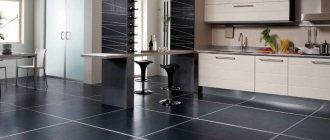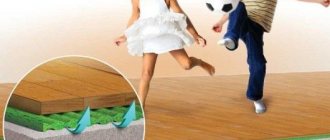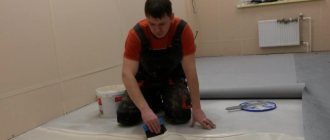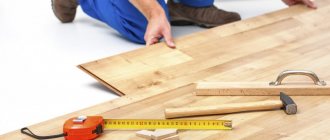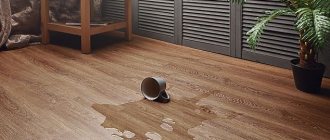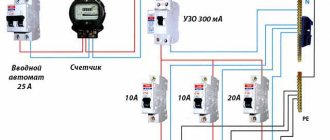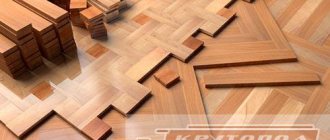Laminate
Today's market is filled with different types of laminate flooring, which differ in color, pattern, quality and cost. It should be noted that different types of material may differ in price, but this does not mean that they have a big difference in quality.
Characteristics
Laminate is a panel 15-40 cm wide, its length is 1-1.5 m, and its thickness varies from 4 to 12 mm.
It consists of several layers, each of which plays its own role.
- The bottommost layer consists of a waterproof material - tarred or unrefined paper. It helps preserve the floor covering on the main floor side. This layer can also have a soundproofing coating or a stand-alone backing.
- The main dense layer of the laminate is made of wood fiber, pressed into a board with a thickness of 4 to 12 mm. Its rigidity holds the shape of the panel, and there are tongue-and-groove fastenings on it, with the help of which a monolithic floor covering is created.
- The next layer is decorative. It consists of a laminated film, which has various patterns that imitate different types of wood, stone, parquet, sand and other materials.
- The top layer protects the laminate from mechanical stress such as scratches or abrasion. It consists of acrylic or melamine resins, which are applied in several layers. Their number varies from two or more - the more there are, the more reliable and durable the coating.
This top layer is used to determine the class of the laminate.
Coating properties
Laminate panels, like any building material, have their positive and negative qualities.
Advantages
Laminate is light in weight, but can withstand greater loads than wood flooring. It is moisture resistant and hygroscopic, it does not crack. Thanks to the protective film, it is resistant to scratches and abrasions.
This also includes its resistance to ultraviolet radiation - it does not fade or change color over time.
Its practicality is obvious, since once you install it, you can forget about the problem of repairing the floor for decades.
Environmental friendliness
Laminate is based on natural materials and does not contain resins or formaldehydes harmful to the human body, unlike other floor coverings.
Its production is subject to high material safety requirements, so it can be safely installed in any room of the house or apartment.
Aesthetics
Laminated film perfectly imitates the pattern of any texture, be it wood or stone.
The laid laminate flooring is almost impossible to distinguish from natural parquet. Designers use this material for general interior design, using its aesthetic qualities.
Hygiene
Since laminate is moisture resistant, mold cannot grow on it. The material is easy to clean - just regular wet cleaning is enough.
The laminate panels fit so tightly against each other that dirt particles cannot get between them.
This can also be attributed to its positive properties.
Flaws
This flooring has significantly fewer negative qualities than positive ones, but they still exist:
- some types of laminate can attract dust and small debris due to the fact that they can accumulate static electricity;
- the material is not able to make the floor as warm as natural parquet can do.
These are almost minor negative points compared to all its advantages. But it should be noted that these shortcomings are completely correctable.
Choosing what is better to put in the house: laminate or linoleum
Each room is characterized by the peculiarities of its use; accordingly, it is advisable to take such indicators into account when choosing a floor covering so that shortcomings are not revealed.
Features such as humidity, traffic, and temperature changes are taken into account.
In living rooms, for example, in the living room, it is better to choose laminate, which is much more environmentally friendly than linoleum. You can walk on laminate flooring barefoot. Modern interiors require laminate flooring, and it is very popular. The design looks very fashionable and modern.
Related article: Repair school on TNT
In rooms with high humidity or large temperature differences, it is better to lay linoleum
The main advantages of linoleum and laminate:
- Varied price selection;
- A variety of color coatings can be selected to suit any interior;
- Easy installation;
- The surface is warmer;
- The synthetic composition allows the material not to deteriorate;
- Absorbs sounds;
- Increased strength;
- More expensive laminate options have more useful properties, and you can also choose cheaper material;
- Laminate flooring imitates wood, ceramics, sand, etc., is easy to install and does not require special skills or tools.
It is recommended to cover the floor in the kitchen with linoleum. This coating can be washed very often, it is moisture resistant and does not erase the image on the surface. In the kitchen, laminate flooring will not last long, unlike linoleum. In a room with high traffic, it is recommended to lay linoleum, which will absorb sounds. When using laminate, squeaks often occur, and the pattern wears off over time; additional repairs may be required. Linoleum will be very appropriate for a loggia. If the temperature changes and there is frost, the laminate will deteriorate. The cheaper the coating, the lower its strength and wear resistance. The more expensive the material, the longer its service life.
Linoleum
Linoleum is a rolled flooring material. It is available in several types and with a variety of patterns, has many colors and shades. It can be easily selected to suit every taste and any interior.
Characteristics
- Linoleum is produced in different thicknesses - thin and insulated, in widths of 1.5 m, 2 m, 2.5 m, 3 and 4 m.
- The thickness of the baseless thin coating varies from 1.2 to 1.6 mm.
- Insulated has a foam backing from 2 to 4 mm, and linoleum with a warm thick base can have a thickness of 1.5 cm.
If thin linoleum is laid, the floors under it are leveled to perfect condition.
A coating on a thick base can easily hide small irregularities.
Types of linoleum
This flooring is available in several types and from different materials:
- PVC linoleum is the most common type of this covering; it is produced without a base and on a heat-sound-insulating or fabric base.
This material is also divided into homogeneous (single-layer) and heterogeneous (multilayer) types:
- Heterogeneous linoleum consists of several layers. The first, lower one is a foamed or insulated backing, followed by a decorative layer with a pattern and a transparent top one - a protective film.
- Homogeneous linoleum is a material whose pattern runs throughout its entire thickness, so it is not afraid of abrasion. This type is good for laying in places with high traffic.
PVC linoleum does not tolerate temperature changes well; it is deformed when it significantly increases or decreases.
- Colloxyline linoleum - made from nitrocellulose without a base, it is elastic and waterproof, but it is almost never used in residential premises, as it is a fire hazard.
- Alkyd or glyphthalic linoleum - made on the basis of alkyd resin, on a fabric backing. This type of linoleum has good heat and sound insulation properties compared to PVC.
The disadvantage of this type of flooring is that it does not tolerate low temperatures well, it becomes brittle and can break.
- "Relin" is linoleum made on a rubber base.
Its bottom layer consists of recycled rubber mixed with bitumen, which is covered on top with rubber, to which fillers and pigments have been added.
Positive and negative qualities of linoleum
Advantages
Linoleum has a large number of positive qualities, which is why it is very popular:
- Affordability makes it possible for even a family with an average income to purchase the most expensive option;
- Easy to care for - linoleum does not require much effort when cleaning, just wipe it with a damp cloth or walk over it with a vacuum cleaner;
- The material makes it possible to move around it silently, which contributes to the creation of comfort;
- A coating on a warm substrate, having a thickness of 1.5 cm, can create good sound insulation for the floor in an apartment;
- Linoleum has a fairly low thermal conductivity, so the floor will not be cold, even if you lay linoleum on a concrete floor.
Naturally, in this case it is better to choose thick linoleum on a warm backing; - The form of the material and its width basically always allows you to lay it yourself in an apartment or house, without using joints of the canvases. If you still had to connect two pieces, you can use glue for cold welding of linoleum;
- The abundance of colors, shades and patterns allows you to make the necessary choice for any room;
- Long service life, which ranges from 10 to 15 years.
Flaws
The flooring also has its disadvantages, which you also need to know about:
- The material is not made on a natural basis and is an artificial product. The exception is natural linoleum, but it has not yet become widespread;
- Not resistant to chemical influences (solvents, dyes);
- reacts to changes in temperature conditions, while it becomes fragile and can be deformed;
- Vulnerability when coming into contact with hot objects;
- Traces from furniture placed on it remain on the linoleum, which are not subsequently removed;
- Moving furniture on this flooring is strictly prohibited, as it can be easily fatally damaged, it may become deformed or, at best, scratches will remain on it.
Nice laminate or practical linoleum: what to choose
When choosing, you need to focus on the resistance of the material to environmental influences. You should handle laminate flooring with care if it is laid in the kitchen, since it cannot be washed frequently with a very wet cloth using chemical detergents, and if objects fall, the surface can be seriously damaged.
In bedrooms and children's rooms, it is better to give preference to laminate
For example, a knife falling with a blade onto linoleum damages the surface through and through, which significantly spoils the appearance and the resulting damage increases over time.
However, the advantage of linoleum is that it is not afraid of wet cleaning; it is strictly forbidden to pour water under the surface, which threatens the formation of mold, bumps or waves.
When carrying out repair work, you can significantly increase thermal conductivity by using a special layer.
Nuances:
- Using additional insulating substrates, the floors will be significantly warmer with any covering.
- Linoleum, thanks to a wide color palette, can be chosen to suit any interior.
- Some colors of linoleum imitate more expensive materials; the interior looks expensive and is suitable even for a rich design.
- If the floor has minor unevenness, then laminate is better suited, and if one board is damaged, it can be easily replaced with a new one.
- The linoleum will have to be changed completely, the only thing that can be done is to lay a patch and fix it with cold welding, however, the aesthetics will deteriorate greatly.
- Laminate has greater thermal conductivity than linoleum.
Related article: How to remove super glue from hands at home
It is imperative to compare the quality of the uncoated floor with the material that can be used for this. For example, if the surface is uneven, linoleum will emphasize the unevenness, and the height peaks will be greatly abraded during use. Floor leveling may be required before installation.
Material comparison criteria
If you are faced with the question of choosing between these materials, you need to make a comparison and identify all the pros and cons of linoleum and laminate.
Floor coverings have not only fundamental differences, but also similarities, so if you rely on them, the materials can sometimes become interchangeable.
comparison table
| Qualities | Linoleum | Laminate |
| Durability | The service life depends on the type, class and quality of the material, as well as the correctness of its operation, and on average ranges from 10 to 15 years | The same as for linoleum, but the service life is from 12 to 20 years |
| Water resistance | Both materials are water resistant because they have protective coatings. Given this quality, they can be considered interchangeable. | Interchangeable with linoleum. |
| Thermal conductivity, which is warmer. | This property of the material depends on the thickness of the coating and on the substrate present; some types may be equivalent. | The same as for linoleum. |
| Soundproofing | The level of sound insulation also depends on the thickness of the material, but generally it is higher for linoleum than for laminate. | The same as for linoleum. |
| Fire safety and toxicity | The material may have different levels of this indicator, which is indicated on the packaging by letters and numbers from G1 to G4. Toxicity is also indicated by a letter and a number in increasing order from T1 to T4. | The material is less flammable, so this indicator is not always indicated on its packaging. |
| Laying the material | The covering is easy to install, and this work can be done independently: if the width of the linoleum matches the width of the room. In some cases, it is necessary to connect the blades using special welding. | Having studied the laying technology, you can easily lay the material. |
| Care | The floor covering is easy to clean with wet cleaning. | Laminate flooring is easy to maintain, just like linoleum. |
| Design | Linoleum has a richer range of colors and a variety of patterns. | Laminate is not as rich in colors as linoleum. |
| Strength | Not as durable as laminate. | Laminate is a more durable material than linoleum. |
| Mechanical resistance | Dents from furniture and heels may form on the coating. Moving furniture can damage or even tear linoleum. Animals will not be able to damage the material with their claws. | Resistant to various mechanical influences, including abrasion. |
| Environmental friendliness, which is more harmful than laminate or linoleum. | The material is artificial, so it can cause allergic reactions. | It is environmentally friendly, as it contains a minimum of non-natural ingredients. |
Based on this data, you can decide which material is most suitable for your room.
Laminate or linoleum: choosing which is cheaper
Before choosing a coating, you need to compare the pros and cons of laminate and linoleum. The building materials market has a diverse range of products of varying quality, and, accordingly, pricing policies. For many, the pressing issue is not only the quality of the material, but also its price. Before purchasing, many people focus only on the price.
The cost of the material greatly depends on environmental friendliness and wear resistance class.
Main disadvantages of materials:
- Linoleum is less environmentally friendly compared to natural materials;
- Pressed under heavy furniture;
- The most budget option, not resistant to temperature changes;
- Allergies may occur;
- When laying laminate flooring in the kitchen, the service life is reduced to 5 years;
- Less environmentally friendly than wood flooring;
- The surface is subject to mechanical damage;
- Frequent washing with aggressive cleaning agents causes white spots to appear;
- Dirt and dust get into the joints between the panels; This causes the edge to deteriorate and its service life to be significantly reduced;
- If a large volume of water gets in, you have to completely change the coating.
Related article: Living room bedroom design options with a partition
Before going to a hardware store, it is advisable to calculate the required amount of material, and also determine how much you can spend on covering the floor. Focusing on wear resistance, laminate or linoleum is selected. If the floor covering is often used, choose one that is more wear-resistant. The price of the material will directly depend on the strength; the higher the wear resistance, the higher the price. More expensive material will be more practical.
Material prices
Prices for laying flooring per 1 m2 vary: for laminate from 120 to 550 rubles, for linoleum from 80 to 300 rubles.
What will cost more: laminate or linoleum? Let's compare prices.
Price table for linoleum
| Price | Class | Thickness in cm | Material of manufacture | Price per 1 m2 in rubles |
| Inexpensive | Domestic | From 0.2 to 0.4 | PVC | 120 — 390 |
| Commercial | From 1 to 1.7 | Rubber | 600 — 900 | |
| Semi-commercial | From 0.2 to 0.4 | Alkyd | 230 — 320 | |
| Average | Domestic | From 1.5 to 0.3 | Colloxylin | 240 — 550 |
| Commercial | From 1 to 2.5 | Rubber | 515- 580 | |
| Semi-commercial | From 0.2 to 0.4 | Alkyd | 480 — 525 | |
| Premium | Domestic | From 0.2 to 0.5 | PVC | 365 — 600 |
| Commercial | From 1 to 4 | Rubber | 1600 — 3000 | |
| Semi-commercial | From 0.2 to 0.4 | Alkyd | 520 — 650 |
Laminate price table
| Price according to rep. | Class | Size in mm | Price per 1 m2 in rubles |
| Inexpensive | 31-33 | 195×1215 | 265 — 385 |
| Average in price | 31-33 | 165×1215 | 285 — 890 |
| Premium | 31-33 | 400×800 | 340 — 1400 |
What rooms are the materials suitable for?
Laminate and linoleum are divided according to strength by the criteria of cross-country ability, i.e. wear resistance. Public organizations and buildings need a coating that can withstand the passage of a large number of people for a long time; office premises also need to be covered with reliable, durable material. Therefore, floor coverings are available in several classes.
Laminate classification
It is indicated on each package with two numbers, the first of which indicates the intended use for residential or non-residential premises, and the second indicates the degree of strength of the coating:
- material for living rooms is indicated by numbers from 21 to 23,
- for non-residential and work premises from 31 to 33.
But it should be noted that recently many manufacturers are refusing to produce laminates of class 21-23, since materials of class 31-33 are more popular, since in terms of their environmental friendliness they are no different from coatings for residential premises.
- 31 - laminate for offices where there is no heavy load on the coating, also good for bedrooms ;
- 32 - material for public organizations with more intense traffic, for the home, it is well suited for the living room, balcony and bathroom ;
- 33 - laminate for rooms with heavy traffic, where it bears heavy loads, for example, shops and hotels. In residential premises, this class of coating is installed in the hallway or kitchen.
